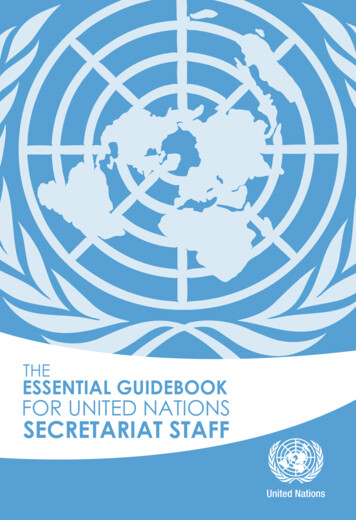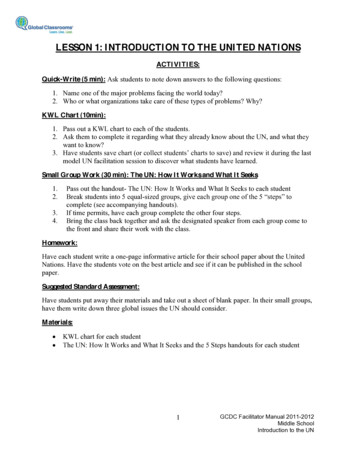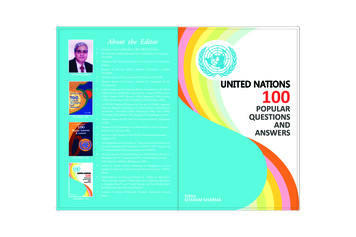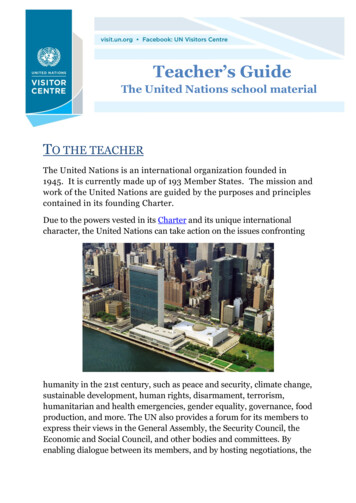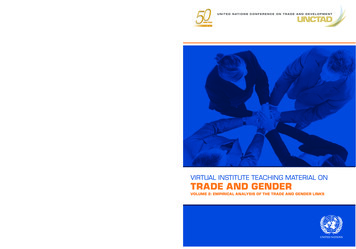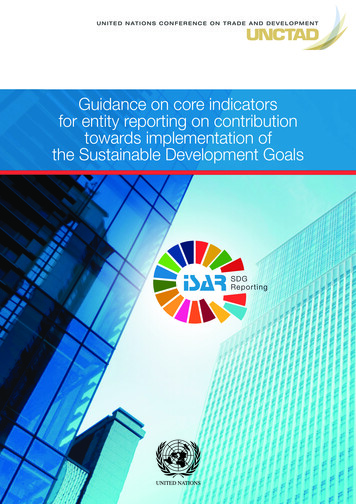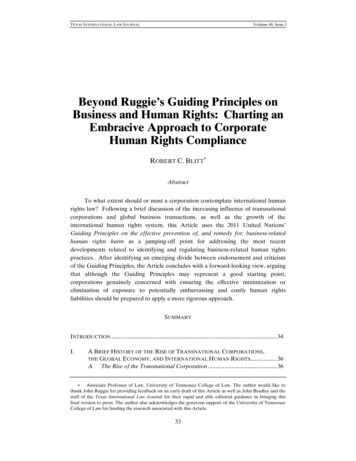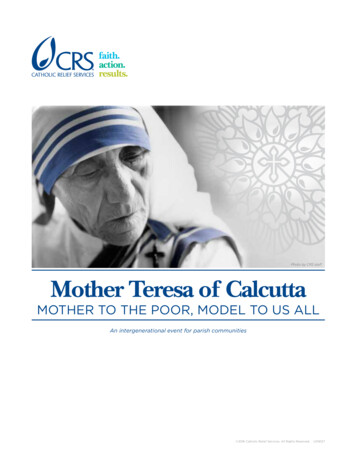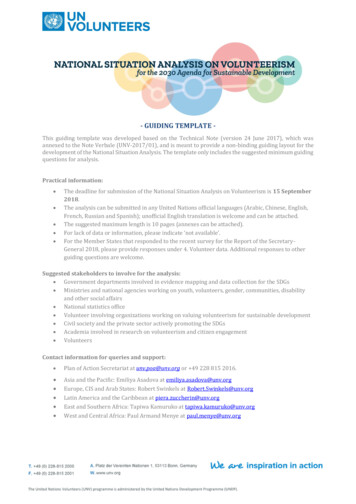
Transcription
- GUIDING TEMPLATE This guiding template was developed based on the Technical Note (version 24 June 2017), which wasannexed to the Note Verbale (UNV-2017/01), and is meant to provide a non-binding guiding layout for thedevelopment of the National Situation Analysis. The template only includes the suggested minimum guidingquestions for analysis.Practical information: The deadline for submission of the National Situation Analysis on Volunteerism is 15 September2018.The analysis can be submitted in any United Nations official languages (Arabic, Chinese, English,French, Russian and Spanish); unofficial English translation is welcome and can be attached.The suggested maximum length is 10 pages (annexes can be attached).For lack of data or information, please indicate ‘not available’.For the Member States that responded to the recent survey for the Report of the SecretaryGeneral 2018, please provide responses under 4. Volunteer data. Additional responses to otherguiding questions are welcome.Suggested stakeholders to involve for the analysis: Government departments involved in evidence mapping and data collection for the SDGs Ministries and national agencies working on youth, volunteers, gender, communities, disabilityand other social affairs National statistics office Volunteer involving organizations working on valuing volunteerism for sustainable development Civil society and the private sector actively promoting the SDGs Academia involved in research on volunteerism and citizen engagement VolunteersContact information for queries and support: Plan of Action Secretariat at unv.poa@unv.org or 49 228 815 2016. Asia and the Pacific: Emiliya Asadova at emiliya.asadova@unv.orgEurope, CIS and Arab States: Robert Swinkels at Robert.Swinkels@unv.orgLatin America and the Caribbean at piera.zuccherin@unv.orgEast and Southern Africa: Tapiwa Kamuruko at tapiwa.kamuruko@unv.orgWest and Central Africa: Paul Armand Menye at paul.menye@unv.org
[insert country name][insert date completed][insert contact details (name, title, e-mail, phone)]1.Conducive environment1.1 Volunteer related legislation, policies or other regulatory frameworksGuidance: To identify the presence of favourable legislative and policy conditions that promote volunteerism.Guiding questions: What is the name of the law or policy (in national language and in English)? When did it enter into effect? Why was it created? How is it favourable to the promotion of volunteerism? For example, does it include safety and wellbeing aspects for volunteers? How is the status of volunteers defined (in the laws mentioned above or in the country)? Is there a plan to develop (if not available at the moment) specific legislation? If so, is there a timelineavailable? What will the legislation be about? Please add anything else relevant.1.2 Incentives for volunteers for recognition and promotion ofvolunteerismGuidance: To identify whether incentives and/or special recognition is given to volunteers/volunteer work.Guiding questions: Do incentives exist to recognize contributions made by volunteers? Are they cultural, customary, orregulated by specific policies and legislation? Examples: Awards, benefits, insurance or other safetynets, volunteer “passport”, public events. Does the country observe the International Volunteer Day (5 th December)? If so, how? Are there any public figures who have been nominated or are considered the champions ofvolunteerism? If so, who?1
1.3 Budget allocation for volunteerism-related national agendaGuidance: To determine whether specific allocations are made to promote volunteerism at the national or subnational level.Guiding questions: Does the country have a dedicated budget allocation to promote volunteerism at national or subnational level? If yes, what is the annual allocation (estimates since 2016 if possible)? If not, what are the reasons for no allocation and is such allocation foreseen in the future? What are the priorities under such allocation? (e.g. Awareness-raising on volunteerism for the SDGsin communities, youth engagement)1.4 Reflections based on the above How do values and traditional and cultural norms inform volunteerism in different contexts thatcontribute to peace and development?What are the critical conditions that allow volunteerism to leave a positive mark on peace anddevelopment? and;What does the above knowledge reveal about the future promotion of volunteerism?What are the current challenges?2
2.Functioning schemes and organizations2.1 National volunteer schemes, organizations and plansGuidance: To identify the presence of volunteering opportunities for common national peace and developmentobjectives that encourage mutual support, physical and mental well-being, citizen engagement, skills-building,employability and leadership development through volunteering.Guiding question: Are there national volunteer schemes, organizations or plans? Please provide names, brief descriptionand supporting information (e.g. websites, leaflets). What type of activities are considered volunteering?2.2 Engagement of volunteers in the achievement of SDGsGuidance: To identify the relationship between volunteers/volunteer work and the achievement of theSustainable Development Goals.Guiding questions: Is the country involving volunteers at the national and sub-national level to implement the SDGs? To what specific SDGs do volunteers contribute? Please provide examples. What is the added value of volunteers in the process described above? Are volunteer groups part of multi-stakeholder engagement to review and follow up on theimplementation of the SDGs (e.g. Voluntary National Review)?2.3 Reflections based on the above What does the process of volunteering add to development that paid work does not?3
3.What value does volunteerism add to the sustainable development process and its outcomes?How does volunteerism make development more efficient, effective and sustainable?What contribution does volunteerism make at the individual, community and nationaldevelopment levels?What are the current challenges?Impact assessment, monitoring and evaluation of volunteerinitiatives3.1 Mechanisms and tools to collect data on volunteerismGuidance: To review what mechanisms exist to capture the scale and scope of volunteerism at the national andsub-national level.Guiding questions: Is the country (e.g. through the national statistics office) collecting data on volunteerism? If so, pleaseindicate surveys/tools used and the type of data generated. Annex if necessary. Is there a national indicator on volunteerism as a means to achieve the SDGs? If not, how are thevolunteer contributions integrated for the SDGs? Please provide information on past/ongoing/future research to measure the impact of citizenengagement in sustainable development, including both national and international contexts underthe 2030 Agenda for Sustainable Development (e.g. economic value of volunteering, volunteercontributions to the 2030 Agenda and the SDGs).4
3.2 Reflections based on the above 4.Please add any additional points related to measuring the impact of volunteering.What are the current challenges?Volunteer data4.1 Registered volunteersGuidance: To record the number and type of registered volunteers in the country.Guiding questions: Please provide information on the total number of registered volunteers disaggregated, wherepossible (e.g. gender, average age, informal/formal nature of volunteers, Red Cross/Red Crescentvolunteers). What is the source or methodology used to collect the information above? If no or partial information is available, is there a plan to take steps towards collecting thisinformation?4.2 Registered volunteer organizations and networksGuidance: To assess the number and type of volunteer organizationsGuiding questions: Please provide information on the total number of registered volunteer organizations disaggregated– where possible – by national/international origin, type of organization (e.g. association, NGO,foundation), size (by number of volunteers), and thematic focus. What is the source or methodology used to collect the information above? If no or partial information is available, is there a plan to take steps towards collecting thisinformation?5
4.3 Volunteer-sending countryGuidance: To determine the volunteer contributions of the country internationally.Guiding questions: Does the country send volunteers abroad? When available, please indicate the first year on record (i.e.when did it start?), current or recent annual count, geographical and thematic focus. What is the source or methodology used to collect the information above? If no or partial information is available, is there a plan to take steps towards collecting thisinformation?4.4 Volunteer-hosting countryGuidance: To determine the presence of international volunteers in the country.Guiding questions: Does the country host volunteers from abroad? When available, please indicate the first year on record(i.e. when did it start?), current or recent annual count, geographical and thematic focus and whichorganizations provide the volunteers (e.g. UN, bilateral). What is the source or methodology used to collect the information above? If no or partial information is available, is there a plan to take steps towards collecting thisinformation?6
4.5 Reflections based on the above Please add any additional points on the availability of volunteer data or data collection gaps etc.What are the current challenges?7
- GUIDING TEMPLATE - This guiding template was developed based on the Technical Note (version 24 June 2017), which was annexed to the Note Verbale (UNV-2017/01), and is meant to provide a non-binding guiding layout for the . Plan of Action Secretariat at unv.poa@unv.org or 49 228 815 2016.
